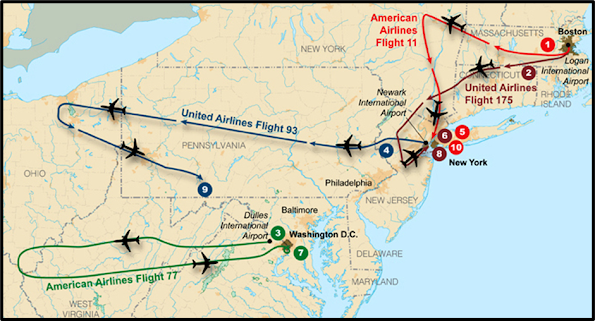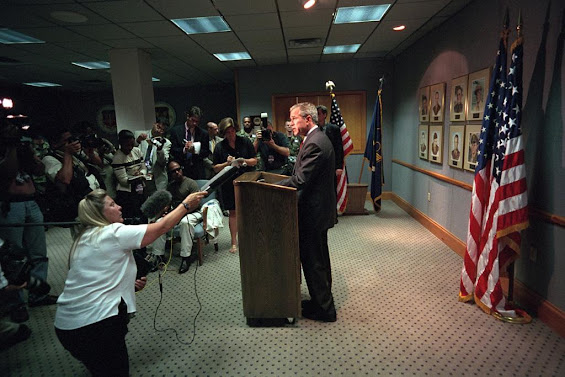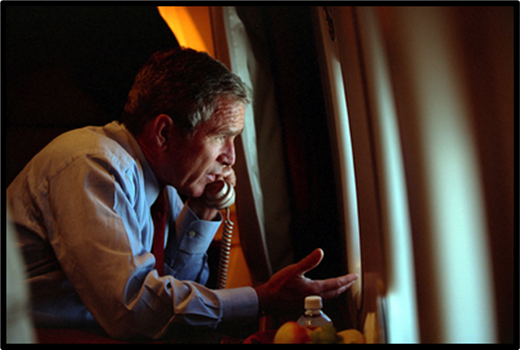Type Of Activity | Crisis Management |
Location | |
Location | The White House, Washington DC |
Date of Activity | 1942 to Present |
Coordinates | |
Initially a bunker was constructed in the White House to protect President Franklin D. Roosevelt in the event of an aerial attack on Washington DC and this bunker has been an integral part of U.S. national security since World War II. During President Harry S. Truman’s extensive renovation of the White House from 1948 to 1952, the existing bunker was expanded into what is now known as the Presidential Emergency Operations Center (PEOC). Situated beneath the East Wing of the White House, the PEOC is designed to handle nuclear contingencies, serving as a haven of security and communication for the President of the United States and other high-ranking officials during times of crisis.
In 1956 the cold War was becoming a large National issue; President Eisenhower and his Administration was overly concerned about the threat of Nuclear War. The federal Government realized that if an attack would occur that the area around Washington had to be protected so the Government would survive. A plan was approved and implemented, the construction of a communications network around Washington which was included in this plan for the relocation of Government Agencies, including the White House at a few locations that already existed also known as the Continuation of Government (COG). This Proposal presents the size and scope of certain Communications available today, at the National level.
 |
| The East Wing of the White House |
 |
| The Presidential Emergency Operations Center (PEOC) in the East Wing of the White House |
The new system enhanced both the White House Admin Switchboard and WHCA’s Signal Switchboard, which consisted of 4,000 leased Centrex lines feeding three AT&T Definity GR 3 PBX switches with digital consoles. Lucent 8410 telephone sets are used with the internal telephone network for non-secure calls. The PEOC was also upgraded with modern communication equipment, including televisions and phones, to coordinate with external government entities. Secure communication channels, air filtration systems, and other critical infrastructure ensure no detail is overlooked in its construction. The IST telephone has been gradually replaced by the IST-2 since 2003.
The PEOC has been activated on several occasions throughout its existence. Its primary function is to protect the President and other key personnel in case of a security breach at the White House, including violations of the Washington, D.C. Air Defense Identification Zone (P-56 airspace). In such cases, as on September,11 2001, the President and other protectives are relocated to the executive briefing room adjacent to the PEOC.
 |
| North and South Towers of the World Trade Center and the Marriot Vista Hotel at the base of the twin tower |
While officials and other presidents had used the PEOC for drills and exercises, 9/11 was its first test in an actual emergency. The bunker's location is classified, and few are privy to its inner workings. What is known is that it is a massive underground facility with multiple layers, including living quarters, a medical suite, and conference rooms. The operations center, where the watch team fields phone calls, includes a conference room equipped with television screens, and a long conference table.
 |
| PEOC’s executive briefing room |
It was a terrifying, startling, and humbling event for the country. The 9/11 attacks were the deadliest on American soil since the shock attack at Pearl Harbor 60 years before, and the sense of outrage was reminiscent of that moment. The attacks in New York occurred in the country’s busiest city on a busy workday. And the staggered nature of the attacks meant that news footage captured almost everything as it happened, ensuring that millions of Americans saw the events precisely as they unfolded.
Timeline September 11, 2001
5:45 AM – Mohamed Atta and Abdul Aziz al-Omari, two of the intended hijackers, pass through security at the Portland International Jetport in Maine. They board a commuter flight to Boston Logan International Airport; they then board American Airlines Flight 11.
7:59 AM – American Airlines American Airlines Flight 11 a Boeing 767 carrying 81 passengers and 11 crew members, departs from Logan International Airport in Boston, bound for Los Angeles International Airport.
8:14 AM – American Airlines Flight 11 is hijacked over central Massachusetts. There are five hijackers on board
 |
| Flight paths of the hijacked planes |
8:19 AM – A flight attendant on American Airlines Flight 11, alerts ground personnel that a hijacking is underway, and that the cockpit is unreachable.
8:20 AM – American Airlines Flight 77 a Boeing 757 with 58 passengers and 6 crew members, departs from Washington Dulles International Airport, for Los Angeles International Airport.
8:24 AM – Mohamed Atta, a hijacker on American Airlines Flight 11, unintentionally alerts air controllers in Boston to the attack. He meant to press the button that allowed him to talk to the passengers on his flight.
8:37 AM – After hearing the broadcast from Atta on American Airlines Flight 11, Boston air traffic control alerts the US Air Force’s Northeast Defense Sector, who then mobilize the Air National Guard to follow the plane.
8:42 AM – United Airlines Flight 93 a Boeing 757 with 37 passengers and 7 crew members, departs from Newark International Airport, bound for San Francisco International Airport, after a delay due to routine traffic.
8:42–8:46 AM – United Airlines Flight 175 is hijacked above northwest New Jersey. There are five hijackers on board
8:46 AM – American Airlines Flight 11 crashes into the north face of the North Tower 1 of the World Trade Center, between floors 93 and 99. All passengers aboard are instantly killed, and employees of the WTC are trapped above the 91st floor.
8:50–8:54 AM – American Airlines Flight 77 is hijacked above southern Ohio. There are five hijackers on board
 |
| Flight 175 heads toward the South Tower 2 of the World Trade Center |
 |
| Flight 175 crashes into the south tower |
9:28 AM – United Airlines Flight 93 was attacked by hijackers above northern Ohio. There are four hijackers on board and forty passengers and crew members. These forty fought a battle in the sky over Pennsylvania. These 40 heroes voted and decided to fight back, thwarting a planned attack on our nation's capital. They saved the lives of many others, but sacrificed their own in a field just east of Pittsburgh in Somerset County, Pennsylvania
9:34AM American Airlines Flight 77 began turning south, away from the White House. It continued heading south for roughly a minute, before turning west and beginning to circle back. This news prompted the Secret Service to order the immediate evacuation of the Vice President just before 9:36 AM. Agents propelled him out of his chair and told him he had to get to the bunker. The Vice President entered the underground tunnel leading to the PEOC.
9:37 AM Vice President Cheney and the agents paused in an area of the tunnel that had a secure phone, a bench, and television. The Vice President asked to speak to the President, but it took time for the call to be connected and he saw television coverage of smoke coming from the North Tower.
9:37 AM – American Airlines Flight 77 crashes into the western side of the Pentagon. All passengers aboard are instantly killed and so are 125 civilian and military personnel in the building.
 |
| The Pentagon is hit by flight 77 |
 |
| Vice President Cheney in the PEOC |
 |
| President Bush, in Florida, talks to Vice President Cheney |
 |
| Sample screen of approximately 700/800 United Airlines flights in the air at 10:00 AM |
9:57 AM – Passengers aboard United Airlines Flight 93 begin to run up toward the cockpit. Jarrah, the pilot, begins to roll the plane back and forth in an attempt to destabilize the revolt.
9:59 AM – The South Tower of the World Trade Center collapses. 56 minutes after the impact of. United Airlines Flight 175
 |
| The South Tower of the World Trade Center collapses |
 |
| Shanksville, Pennsylvania the site where flight 93 crashed |
10:18 AM – After the planes struck the twin towers, a third took a chunk out of the Pentagon. President Bush authorized any non-grounded planes to be shot down. At that time, all four hijacked planes had already crashed but the president’s team was operating under the impression that United Airlines Flight 93 was still in the air. Vice President Cheney then heard a report that a plane over Pennsylvania was heading for Washington. A military assistant asked Cheney twice for authority to shoot it down. The vice president said yes. Then the word came that Flight 93 crashed in Pennsylvania.
 |
| Vice President Cheney in the PEOC on 9/11 |
10:28 AM – The North Tower of the World Trade Center collapses, 1 hour and 42 minutes after the impact of American Airlines Flight 11
 |
| The North Tower collapses |
 |
| The Marriot Vista Hotel |
10:53 AM – Secretary of Defense Donald Rumsfeld orders the US military to move to a higher state of alert, going to DEFCON 3
 |
| AF1 at Barksdale AFB |
 |
| The Air Force Global Strike Command Center at Barksdale AFB |
 |
| President Busch confers with top aides |
 |
| President Busch addresses the nation from Barksdale AFB |
1:30 PM – Air Force 1 leaves Barksdale AFB.
2:30 PM – Rudy Giuliani, the mayor of New York City, visits the fallen Twin Towers of the World Trade Center at what becomes known as Ground Zero.
 |
| Secretary of Defense Rumsfeld and New York Mayor Giuliani at Ground Zero |
 |
| President Bush arrives at Offutt AFB |
3:15 PM, President Bush met with his principal advisers through a secure video teleconference. Rice said President Bush began the meeting with the words, “We’re at war,” and that Director of Central Intelligence George Tenet said the agency was still assessing who was responsible, but the early signs all pointed to al Qaeda. The Secretary of Defense had directed the nation’s armed forces to Defcon 3, an increased state of military readiness. For the first time in history, all nonemergency civilian aircraft in the United States were grounded, stranding tens of thousands of passengers across the country.
 |
| A secure video teleconference with the PEOC |
4:30 PM – Air Force 1 leaves Offutt and heads back toward Andrews Air Force base near Washington, DC. In the late afternoon, the President overruled his aides’ continuing reluctance to have him return to Washington and ordered Air Force One back to Andrews Air Force Base. He was flown by helicopter back to the White House, passing over the still-smoldering Pentagon.
 |
| President Bush returns to Washington |
 |
| Building 7 of the World Trade Center |
 |
| In the PEOC just prior to his speech addressing the events of the day |
 |
| President Bush addresses the nation from the Oval Office |
 |
| National Security Council and others meet in the PEOC ‘s executive briefing room |
 |
| President Bush, the First Lady, Vice President Cheney and others prepare to leave the PEOC for the evening |
Vice President Cheney and his staff were transported by helicopter to Camp David that night, returning to the White House the following day thus ending the need for the PEOC.
The terrorist attacks on September 11, 2001, combined with emerging demands from a tech-savvy administration, emphasized the critical need for reliable, real-time, and secure information flow to the President and his staff. September 11 was the first real test of the Presidential Emergency Operations Center (PEOC) during a crisis, exposing the deficiencies in the existing communication systems. This event underscored the issues the Department of Defense (DOD) had already identified. WHCA had already embarked on a significant modernization effort, and by September 11, they had a clear understanding of what was needed. The attacks only intensified the urgency of these efforts.
The transformation plan for this information technology overhaul included a realignment of core functions and missions within the White House Communications Agency (WHCA), along with a series of technological upgrades. Many of these improvements were initiated before September 11. At the end of 2000, the U.S. Defense Department assessed the President’s communication capabilities, focusing on DOD support to the commander in chief.
In the three years following September 11, there were significant changes in the presidential communication systems, largely driven by WHCA, which accelerated their efforts after the attacks. Although much has been accomplished, continued enhancements are necessary to ensure the President and his staff can fully leverage the benefits of advancing technology.
WHCA began evaluating each of its existing systems, examining their capacities and capabilities, and exploring the potential of Internet technology. This evaluation encompassed everything from office phones to the mobile systems that travel with the President, as well as the communications systems on aircraft. WHCA identified around 41 projects that required attention, prioritizing 11 of the largest and most complex under the Pioneer Project.
This initiative included upgrading all IP networks supporting WHCA’s role in White House operations, converging data, voice, and video on those networks, introducing a new IP-capable mobile band, enhancing the secure voice environment known as the Defense Red Switch Network (DRSN). Which, during 9/11, it came out that the Red Switch did not perform like it should have, and finally to expand the use of various military communications satellites.
In 2010, workers broke ground on the North Lawn of the White House for another underground project. Although officially described as an update to electrical and air conditioning systems, speculation suggests it was a cover for constructing a new White House bunker under the East Wing. While the area reportedly wasn’t in use under President Barack Obama’s administration, some believe the PEOC underwent renovation between 2010 and 2012 as $375 million was used for an upgrade at the White House, it’s probably safe to assume this state-of-the-art shelter features something more comfortable than a few fold-out beds from the 1940s for the principle parties. by almost all accounts part of the project included a new, massively expanded, PEOC—one complete with the latest communications, computer systems, and environmental technologies that could allow the President and their staff to operate unimpeded for extended periods of time during a crisis. In other words, we are likely talking about a fortified, deeply buried, five-story office building—an underground emergency White House if you will—that is in itself akin to a giant Sensitive Compartmented Information Facility (SCIF), which would also make it an ideal locale for holding highly sensitive meetings.
In an increasingly uncertain world, the importance of the PEOC cannot be overstated. It represents the country's commitment to preparedness and dedication to ensuring the safety and security of its people. In the face of adversity, the PEOC stands as a testament to the resilience and strength of the United States, embodying the enduring American spirit.
The tragedy of September 11, 2001 will never be forgotten. The 9/11 Memorial and Museum opened on the site of the former World Trade Center on September 11, 2011, and features reflecting pools in the footprints of where the Twin Towers once stood.

No comments:
Post a Comment